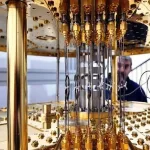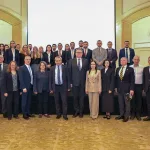Jerusalem, 19 November, 2025 (TPS-IL) — A new Israeli study suggests that light can directly influence materials in a magnetic field in ways scientists had long overlooked, a finding that could affect technologies from fiber-optic communications to advanced computing, the Hebrew University of Jerusalem announced on Wednesday. The Press Service of Israel spoke with the study’s lead researcher, Dr. Amir Capua, and Professor Gadi Eisenstein, an outside expert, about the study’s implications.
The findings could affect technologies that rely on precise light control. Fiber-optic networks and lasers may see improved signal speed and reliability, while spintronics could use light’s magnetic influence to manipulate electron spins more efficiently. The research may also enhance magnetic-field sensors and other precision instruments. The study also points to future advances in quantum technologies and materials research.
For nearly two centuries, scientists believed they understood one of the most straightforward interactions in physics: what happens when light passes through a material placed inside a magnetic field. Discovered in 1845 by English scientist Michael Faraday, this effect became a cornerstone of optics, widely taught and used in numerous technologies.
The new study, published in the peer-reviewed Nature’s Scientific Reports, suggests this long-held understanding may be incomplete. The researchers report that light’s magnetic field — long considered too weak to matter — plays a direct and measurable role. Their analysis indicates that light does not merely illuminate matter; it can exert a magnetic influence on it.
In simple terms, when light passes through certain materials in a magnetic field, its orientation — its polarization — rotates. This is often compared to shining a beam through a piece of glass that slowly twists the light as it emerges. For generations, scientists attributed this rotation solely to the interaction between light’s electric field and electric charges in the material. The magnetic component, considered weaker, was largely dismissed.
“It was treated like background noise,” Dr. Capua, from the Hebrew University’s Institute of Electrical Engineering and Applied Physics, told TPS-IL. He led the research with doctoral candidate Benjamin Assouline.
Their findings paint a different picture. Using advanced spin-dynamics calculations — equations describing the motion of tiny magnetic moments inside materials — the team showed that the magnetic field of light can act on these moments like an applied magnet. In effect, light behaves like a rapidly oscillating magnetic field.
“It turns out the magnetic field in light isn’t passive at all,” Dr. Capua explained to TPS-IL. “It contributes directly to the Faraday Effect — and in some cases quite significantly.”
The researchers examined the effect in TGG, a crystal commonly used in optical devices. Their calculations indicate that at visible wavelengths, light’s magnetic field accounts for roughly 17% of the effect. In the infrared, this rises to about 70%. For a process previously assumed to be entirely electric, the numbers merit a closer look. TGG, or terbium gallium garnet, is a crystal widely used in telecommunications and fiber-optic systems because it efficiently rotates the polarization of light, making it ideal for controlling signals in lasers, isolators, and other optical devices.
While the work remains theoretical, the implications could be broad. The effect plays a role in fiber-optic communications, lasers, sensors, and magnetic-field measurement tools. If light’s magnetic component influences materials more strongly than assumed, future optical devices may operate on different principles or with enhanced precision.
Spintronics, which uses electron spins rather than charge to store and process information, could benefit from faster, more efficient control. “What this discovery suggests is that you could control magnetic information directly with light,” Assouline said.
Light could more precisely control spin-based quantum bits, improving quantum computing and sensing, while its magnetic effect on materials could inspire new optical devices and engineered materials.
Professor Gadi Eisenstein of the Electrical and Computer Engineering Department at the Technion – Israel Institute of Technology, who was not involved in the study, told TPS-IL the work raises important questions. “It’s a noteworthy study. No one had approached it this way. There are potential applications in materials research, detectors, imaging, communication devices. The scope is broad. It will be interesting to see how this develops.”
If light can act as a magnet—even subtly—it may point to additional light-matter interactions yet to be explored. “Light is one of the most fundamental tools we have,” Dr. Capua told TPS-IL. “Understanding that it can magnetically influence matter in ways we didn’t account for suggests there is still more to uncover.”





























